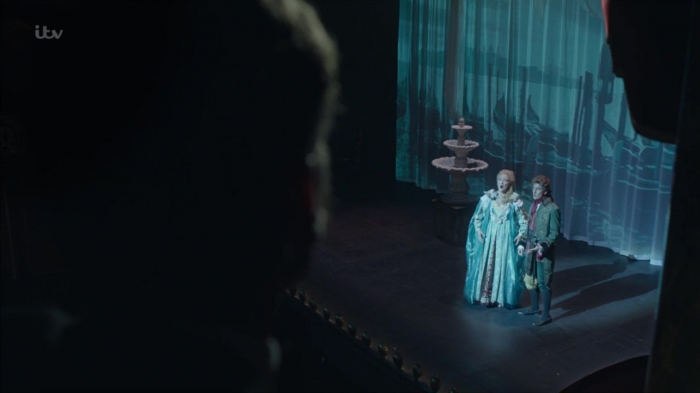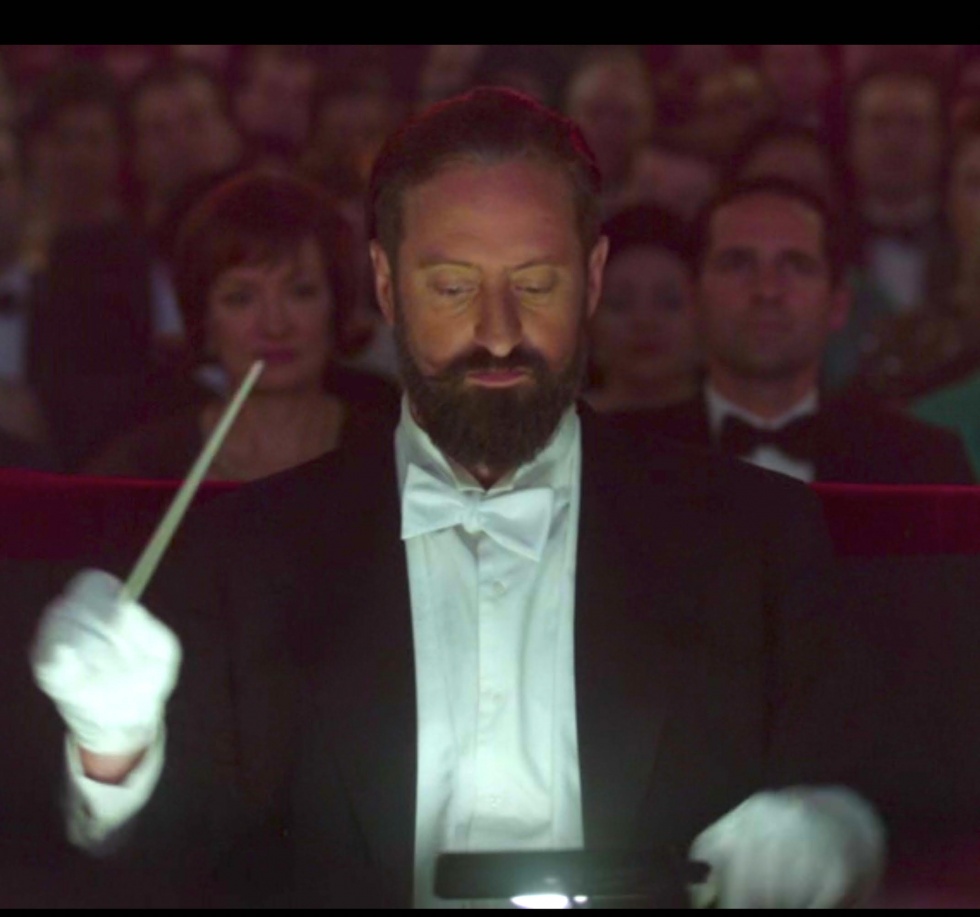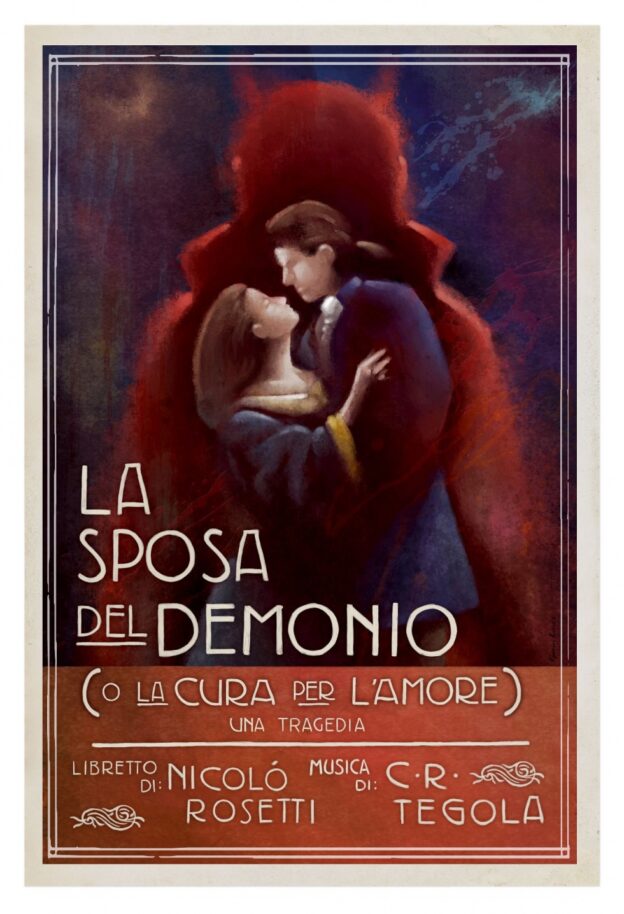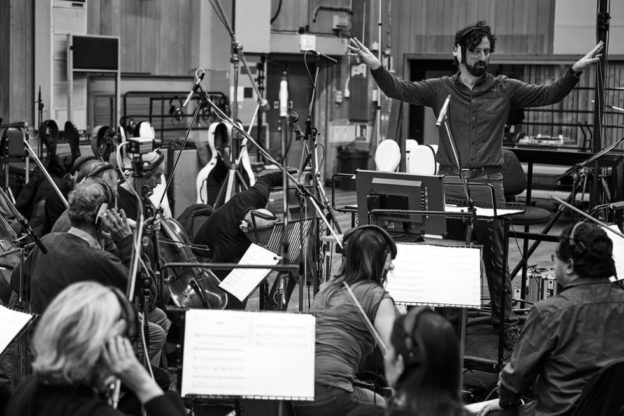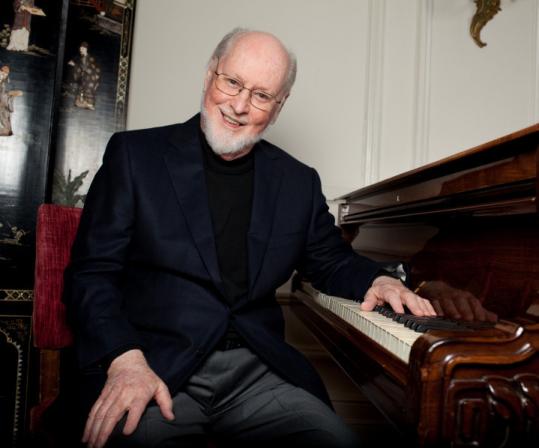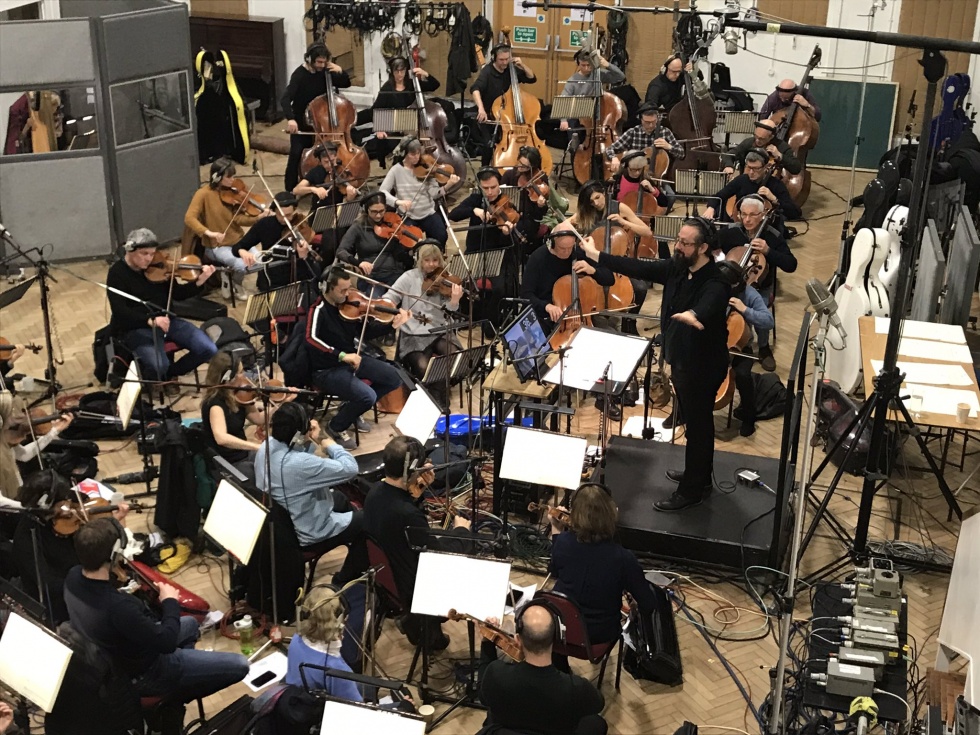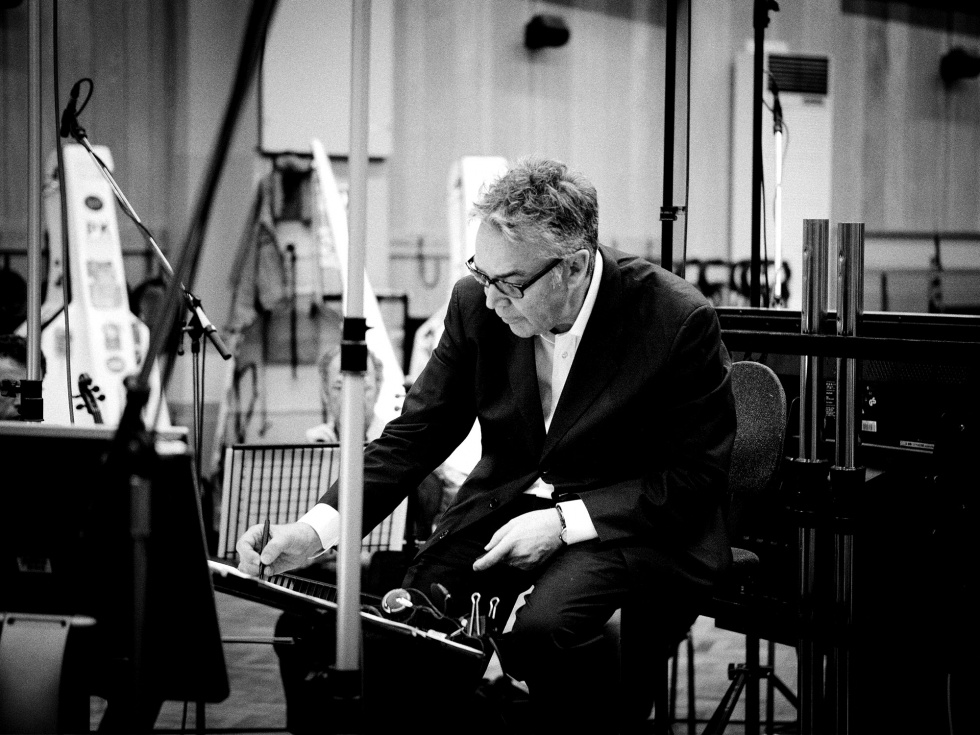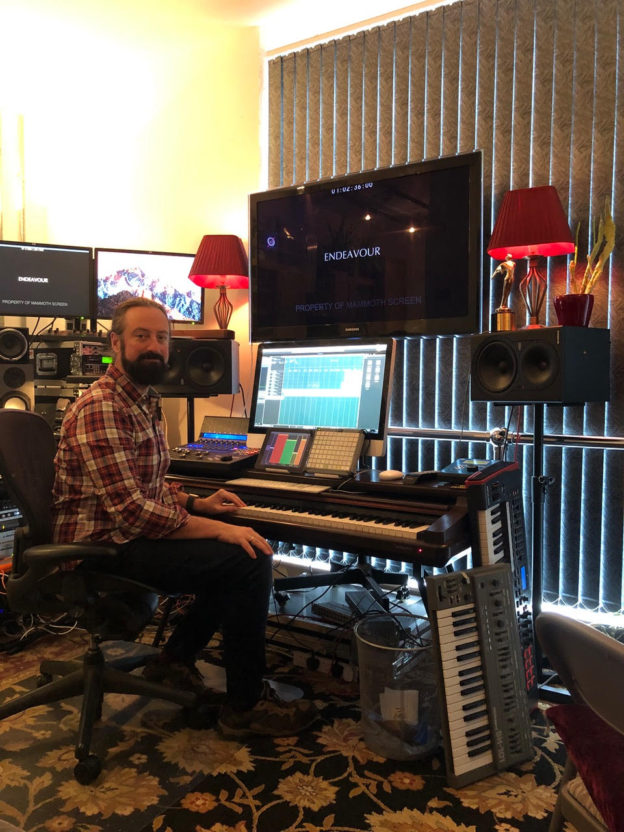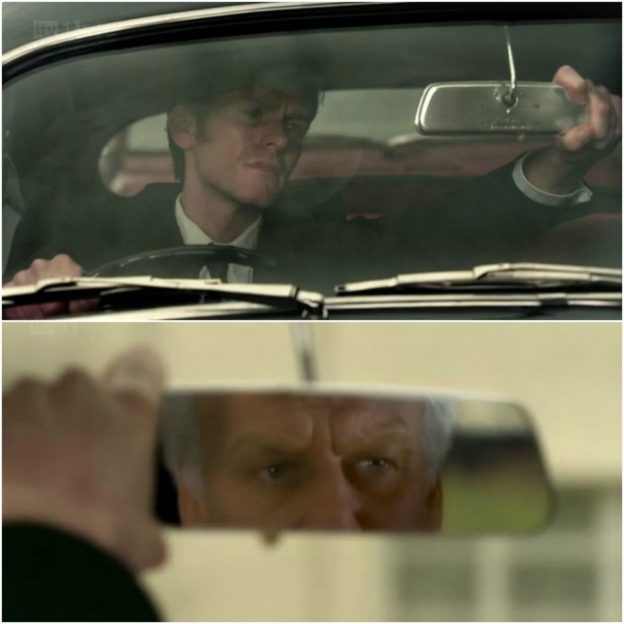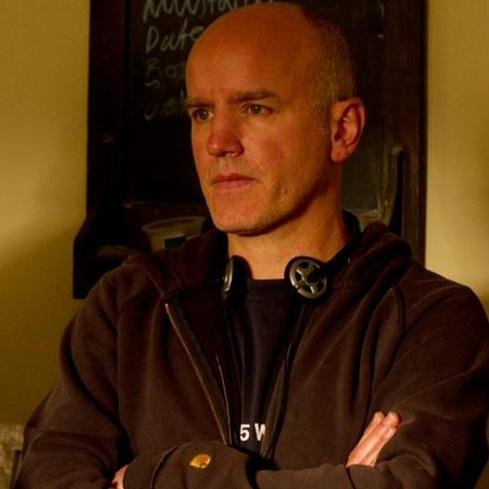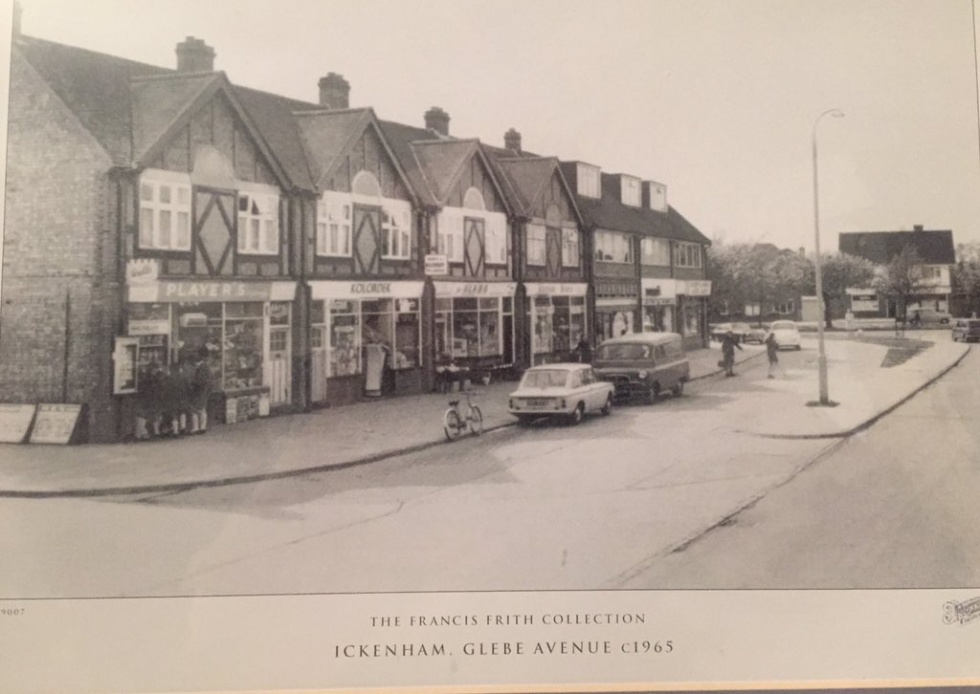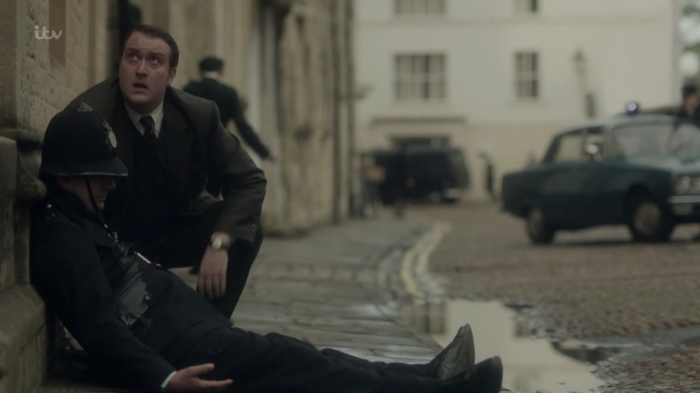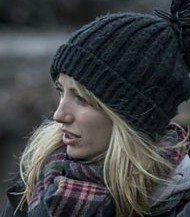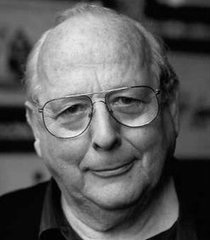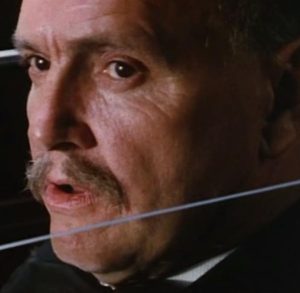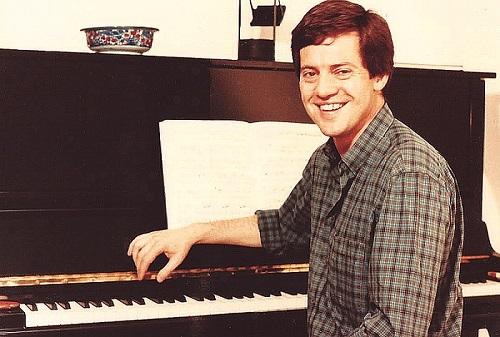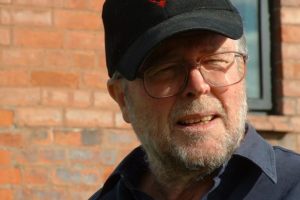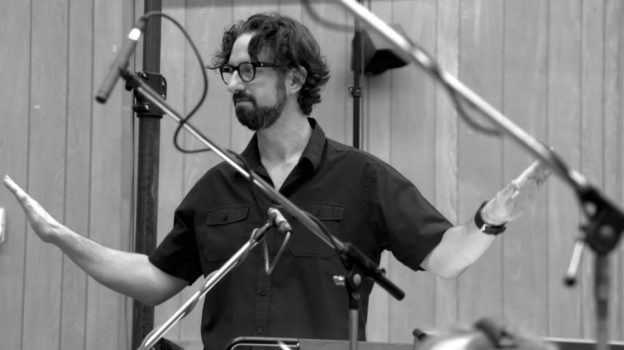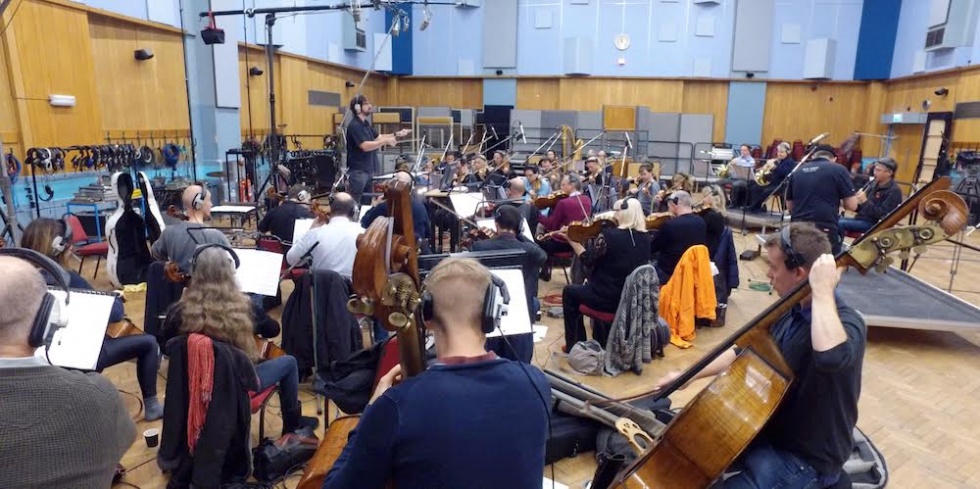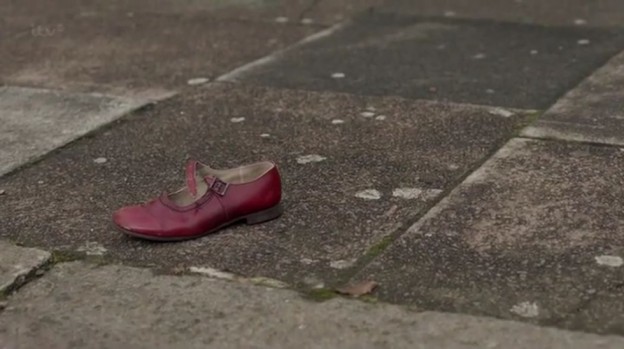Please note that this interview was originally published prior to the broadcast of Endeavour: SWAY (S2:03) on April 13, 2014.
Interview copyright © Damian Michael Barcroft 2016
RUSSELL LEWIS
An exclusive interview
by Damian Michael Barcroft
With thanks to Diogenes Small
and Mr. Tiger
ACT III
‘FUGUE’
(The nut cluster)
We’ve previously discussed FIRST BUS TO WOODSTOCK and GIRL, now we continue our journey through the first series of Endeavour with FUGUE and ROCKET in addition to previewing tonight’s film, SWAY…
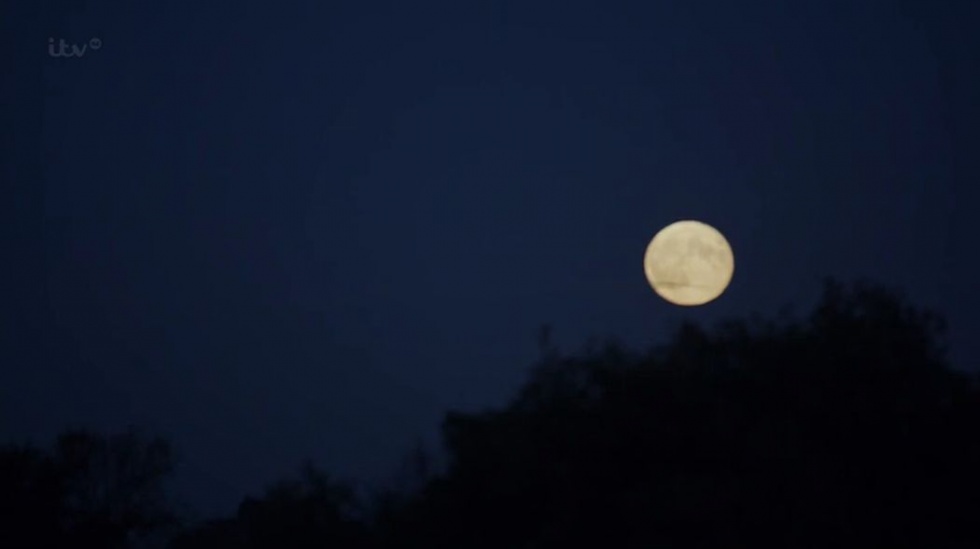
©itv/MammothScreen
DAMIAN: FUGUE was something of a gear change, a race-against-time serial killer thriller. For as wonderful as the swinging sixties were, this was also the decade which witnessed the horrific murders of the Zodiac Killer, Charles Manson and closer to home, Ian Brady and Myra Hindley. You must have been very young at the time but I’m wondering if you can remember these events from your own childhood and if they influenced the script for FUGUE in any way?
RUSS: With the exception of the Zodiac Killer – the rest were a constant presence from as far back as I can remember. The relations amongst whom I lived and grew up were all quite elderly, and the Victorian preoccupations, death and morbidity (we’ll leave spiritualism and the lavatory to one side this time around!) loomed large. I was probably privy to far too many details of the Tate/LaBianca murders at far too early an age. This Be the Verse…
Of course, one says Tate/LaBianca, but in truth it’s the left side of the oblique with which the media, and, through them, the public, was most fascinated. Likewise, the Saddleworth killings have provided the yellow press with easy copy for almost half a century. I doubt there’s many of my generation for whom the perpetrators didn’t occupy far too much imaginary real estate. The maternal side of my family came originally from Barton upon Irwell, so that created an additional, I hesitate to say proprietorial, interest for them, but I suspect that certainly had a part to play. ‘Manchester… so much to answer for.’
But, no – FUGUE was absolutely not influenced by either. I think there may have been a line, I’m not sure whether it was for FUGUE or not, in an early Endeavour draft for one of the films about ‘that business up North’, but I can’t remember now if it ever made a shooting script, or a final edit.
I wouldn’t want to trivialise or exploit any of those crimes by drawing upon them to any major degree, or constructing a direct parallel, in a show like Endeavour. It’s just not the place. Nor the time. If one was looking seriously and specifically at those crimes from a dramatic point of view, fine. But, otherwise… To plunder them for an ‘entertainment’ – to borrow from Graham Greene’s taxonomy – wouldn’t, to my mind, be appropriate. I’m happy to look further back for a jumping off point, but something within such recent living memory… No. I wouldn’t be comfortable with that.
By comparison – and we may be getting ahead of ourselves — the Victorian murders in NOCTURNE sprang from a loose personal connection some thirty-odd years ago with the murder of Francis Savile Kent at Rode (Road) Hill House, which – at the time – led me to The Saint With Red Hands by Yseult Bridges, and another volume by Bernard Taylor, Cruelly Murdered, I think it was, which also dealt with the case. It stayed with me, I suppose. Percolating. Germinating. Waiting its moment.
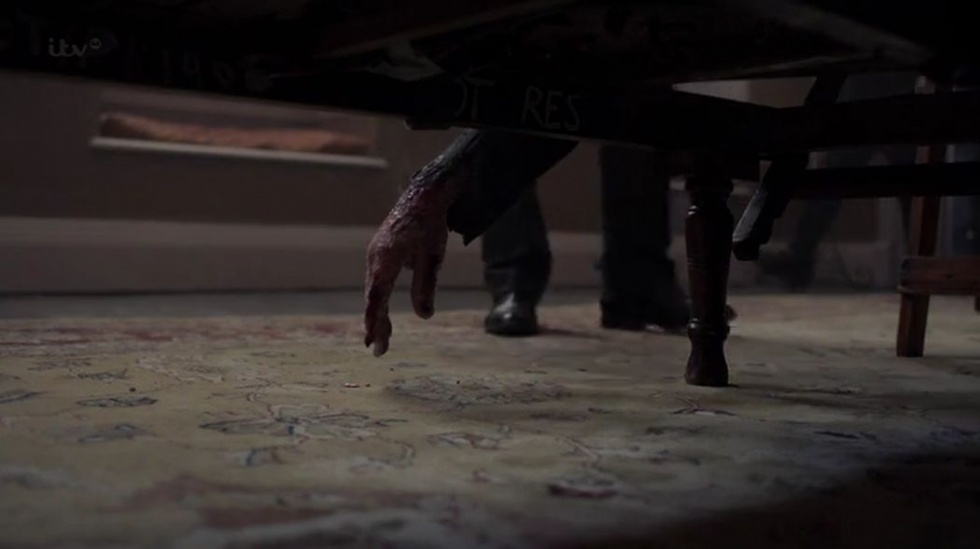
©itv/MammothScreen
It’s now one-hundred and fifty years in the past, and seems far enough removed to draw upon comfortably for something like Endeavour. (It was also drawn on – much closer to the time – to varying degrees by Wilkie Collins and Charles Dickens, and also gets a run-out in a segment of Dead of Night, so we’re in pretty decent company). Yet, even there, our crime is but a faint echo – five murders rather than just the one – of its inspiration. In fact, I think the only direct point of contact is that the respective paterfamilias in both instances share the same forename. Though our Samuel was a tea-planter rather than a Inspector of Manufactories.
One final correction to be made. It’s been suggested that our luckless Victorian police Inspector (who ended his days a broken, hopeless drunk in a cheap rooming-house in Dorking) was a nod to Whicher – whose career never recovered from his failure to bring someone to book for the Rode Hill House murder. The truth is much closer to home. It was an affectionate tribute to the producer of the first series of Endeavour, Dan McCulloch – for whom, sober or not, the description holds some meaning.
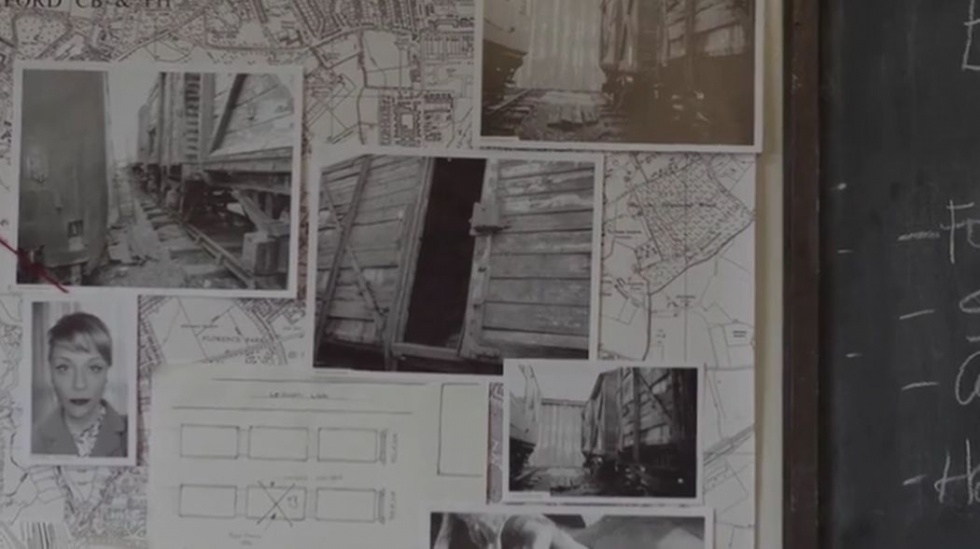
©itv/MammothScreen

©itv/MammothScreen
DAMIAN: Indeed, the psychiatrist, Dr. Daniel Cronyn (aka Mason/Gull), mentions the growing trend in American serial killers and references Charles Raymond Starkweather, Albert De Salvo (The Boston Strangler) and the bodies in the swamp at Fairvale (a nod to Psycho?). Furthermore, FUGUE also features many little allusions such as one of Cronyn’s aliases, Gull, who intends to claim five victims (a favourite suspect of the five canonical Jack the Ripper murders is Sir William Gull) and also the walled up body in the cellar of the farmhouse (Edgar Allan Poe’s The Black Cat?). Do you have a fondness for the horror and Gothic genre?
RUSS: Yes, Sir William (one of Stephen Knight’s now much discredited ‘unholy trinity’) was certainly in my mind – but it was the sense of his surname as a verb that was uppermost. Fairvale – the cuckoo’s egg amongst the rest — was indeed a nod to Hitchcock. The walling up… certainly has Poe associations, but, if anything, I think I would have had A Cask of Amontillado, and the fate of the poorly named Fortunato (and his thousand insults!) more in mind, as he was alive at the time of his immurement, unlike the victim in The Black Cat – but again, the point of departure for all the murders comes back to the first key idea, which was to recreate famous deaths from Opera. Radames fate in Aida was too attractive to ignore. Again – the idea was to attack the thing which gives Endeavour such comfort and pleasure, and taint it in some way. As in FIRST BUS TO WOODSTOCK.
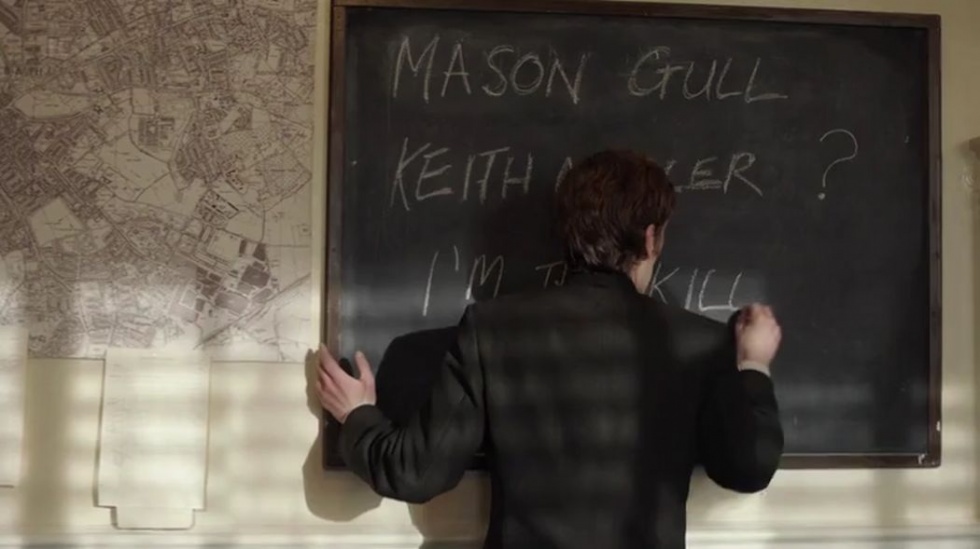
©itv/MammothScreen
A fondness for horror/Gothic? You really will wish you hadn’t asked… One of my early prize possessions was Denis Gifford’s (sometime cartooning and writing partner of Bob Monkhouse, amongst many other achievements!) landmark A Pictorial History of Horror Movies, which I got hold of when I was nine or ten, from WH Smiths at Euston Station. (The important things stay with you.) Later, I acquired some of Alan Frank’s fine guides to the genre.
Universal, RKO, AIP, Amicus, Tigon, and the mighty House of Hammer were as familiar in my mouth as household words. And like many young boys, the Aurora ‘Glow in the Dark’ model kits of the classic ‘monsters’ became an obsession. An obsession clearly shared with the young Mark Petrie… Though, so far as I’m aware, no one ever came scratching at my bedroom window.
This was all in a pre-video recorder/DVD age. But I was lucky enough to be growing up at a time when BBC2 could be relied upon to broadcast a regular Saturday night Horror Double Bill – starting off with the Universals, but, then, moving on to a mix and match of Hammer classics, and many of the Corman/Poe/AIPs. It really was an education.

©itv/MammothScreen

©itv/MammothScreen

©itv/MammothScreen
I was far too young to get into what were then X-Cert films – today’s 18 — which certificate such horror fare invariably bore. But good old TV came to the rescue by delivering the wig-out 70s, and such English curiosities as Scream and Scream Again; Psychomania; the late Hammer Draculas – AD1972; Satanic Rites, &c.; Pete Walker’s output: a brace of Phibes, (the latter featuring Robert Quarry, AIP’s own Count Yorga! for extra meta!) . Though, I suppose, of all that period, the film which casts the longest shadow is The Wicker Man. Ah… Sgt.Howie.
In some small degree FUGUE is a nod to both Phibes, and Edward Lionheart’s (Theatre of Blood) ‘collect the set’ m.o. And also – of course – though the ‘crimes’ were driven by a different motive altogether, Kind Hearts and Coronets. On the literary side… Arthur Conan Doyle’s The Sign of Four, and Dame Agatha’s And Then There Were None.
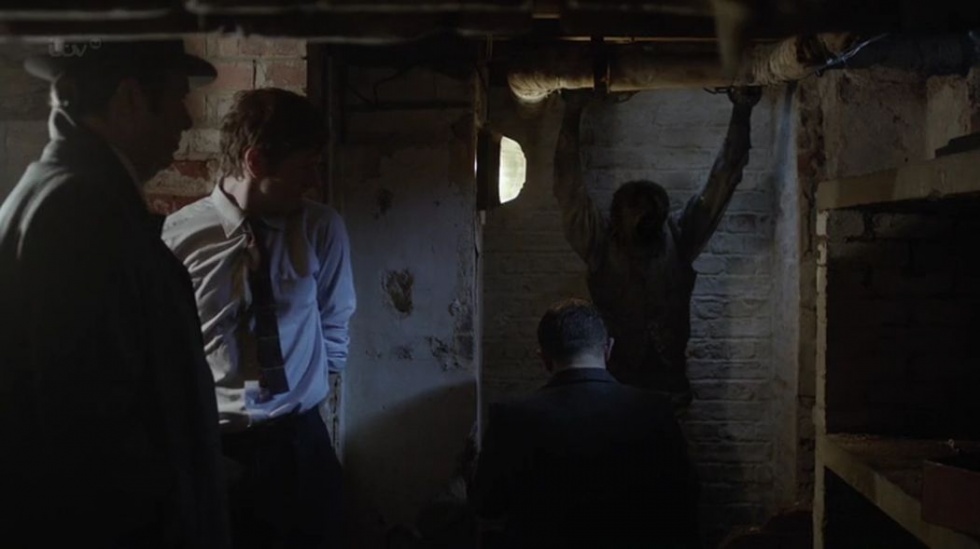
©itv/MammothScreen
We were hugely spoiled – for a brief wee while in the 60s and 70s — with TV shows in the genre; the BBC’s Ghost Stories for Christmas; some ITV adaptations of the classics; Brian Clemens’s long running ATV Saturday night Thriller; Nigel Kneale’s Beasts; and then the BBC’s Supernatural, (mostly) by Robert Muller, came along in 1979 — tales told at the Club of the Damned. Made in studio, and directed multi-cam from the gallery. Staggering set designs and builds — of a kind you’d kill for now.
Robert Hardy wandering haunted canals and sitting at the table of a certain cafe in Ghosts of Venice. Gordon Jackson proving that there was much darkness beyond the kindly Hudson in Night of the Marionettes. Vladek Sheybal channelling Peter Lorre!! Oh my! So many gems. Between them, the Beeb, Network DVD and the BFI have reissued many of the above titles. If you have a taste for such, I can’t recommend them highly enough.
More recently, my fellow Spooks alum., the great LUTHERan, Neil Cross gave us a memorable addition to the BBC’s Ghost Stories for Christmas, with his modern retelling of the MR James story Oh Whistle and I’ll Come to You My Lad. And that appears to have re-established the tradition, though adherence has been sporadic, and more honoured in the breach…

©itv/MammothScreen
No monograph on the subject – which I realise this is turning into – be it ever so brief, would be complete without mention of The League of Gentlemen – Jeremy Dyson, Mark Gatiss, Steve Pemberton and Reece Shearsmith. Keepers of the dark and secret flame, I’m a great admirer of their work — both severally and individually. Their collective admiration, respect and affection for the genre is something to be cherished. Mark Gatiss’s Crooked House trilogy, and, more recently, the Ghost Story for Christmas – The Tractate Middoth — have been particular treats. The three-hander Rope homage in the outstanding Psychoville (Series 1, I think), was something very special indeed. Flawless writing, execution and performance. And now Number 9, and Ghosts, and the Great Detective, etc.. Long may they reign – in all their numerous guises and disguises.
As a boy, I was in and around some of the studios where some of these productions had been made – the Hammers, Amicus, Tigon – and even, I think I’m right, someone will correct me else, an AIP (The Masque of the Red Death was done over here, as I think, was The Tomb of Ligeia) — and, indeed, still were being made. It gave me an enormous kick to be amongst such history.
I was much given to prowling (haunting) empty sound-stages and backlots during lunch breaks. There is a certain… atmosphere on a deserted studio set. A pin-drop silence. Some residual heat from the lights. A particular scent of warm air. To which nothing quite compares. All very Sunset Boulevard, I’m sure, but there is something about bogus corridors and flights of stairs that lead nowhere which, if you have a mind at all susceptible to suggestion, excites the imagination. I found it mesmerising. Thrilling. Perhaps even sacred. Still do. Alas, very little is shot ‘in studio’ these days.

©itv/MammothScreen
Amongst my very earliest memories is playing amongst a whole heap of Dalek casings on the back-lot at Shepperton, which would have been left over from the Peter Cushing Doctor Who outings. For years there was a particular aroma – which took a city boy a lifetime to identify – that I always associated with Shepperton. It drove me mad trying to work out what it was. But it wasn’t until we were in pre-production on TWTTW (The Way Through the Woods) that I was able to solve the mystery.
Chris Burt – who produced TWTTW — had an office in the ‘main house’ at the studio, and I was often holed up there with John Madden as we tried to crack some of the difficulties in adapting Colin Dexter’s novel. (There is a central conceit in the plot which it’s easy to get away with on the page – but because we have to present the thing visually it was as tricky as you like. In fact, thinking about it, there’s a couple of those. Colin is terribly canny and will sometimes tease his readers with a ‘someone saw something’ kind of sentence. Which is great, but how do we shoot it? Which ‘someone’? What ‘something’?)
Anyway, I digress – sorry, this is turning into a Ronnie Corbett story. But there, walking across to the house every day, was this scent again. Only this time, I was able to locate and identify the culprit. What was it that had haunted my senses for thirty-odd years? Only ‘box’ and nothing more… (Now I’ve told you, I can’t help but feel like Eric Idle’s waiter — Gaston, was it? — expounding his philosophy post the Mister Creosote sequence in the Pythons’ Meaning of Life!!) I think this is the point that the Harry Stoneham Quartet start playing the Parkinson theme and we roll end credits.
There’s a Lewis I wrote – my first when I came back onto the flight roster – set around Hallowe’en, which really was a massive nod to all of the foregoing. My love of the genre in film and TV, together with the writings of Poe, Lovecraft, M.R.James and many, many others, all got folded into that story. Falling Darkness, I think it was. I get confused as I did two for that series – the other was titled The Dead of Winter, and centred on Hathaway’s childhood connection to a stately home, and the family who live there. But we didn’t title them until quite late, and it could have gone either way – so I’m never 100 per cent sure which way round it was. It was the same with Series 1 of Endeavour – with the exception of, appropriately enough, FUGUE, the rest were all finally titled at the end of production. If we ever went again, I think I’d probably go back to that model – titles last. Otherwise things leak out – spoilers and so forth, which I’m not too keen on. At all.
One happy coincidence, however, that comes courtesy of my association with Morse, and which closes the circle, is that while we were prepping TWTTW at Shepperton, Sir Kenneth Branagh’s film Mary Shelley’s Frankenstein was shooting on the sound-stages and backlot. Once more I was able to indulge my weakness for wandering deserted sets – this time of a beautifully realised Ingolstadt, and come at last within the baroque – though still memorably melancholy – shade of the House of Frankenstein. Even through adult eyes, the magic was, and is, and will ever remain, undimmed and undiminished.
‘And much of madness, and more of sin – And horror the soul of the plot’!
DAMIAN: FUGUE features more screen time with Morse than is perhaps usual with many scenes in which he is alone. The episode also introduces Thursday’s family for the first time so I’m wondering if this was a deliberate attempt to highlight his isolation and loneliness?
RUSS: If he is alone, it’s probably because we wanted to underline his status – still at this stage very much the outsider. And introducing the Thursdays – their normality pushed the disconnect with the nature of the case.

©itv/MammothScreen
DAMIAN: There’s a wonderful connection to the original series with the explanation as to why Morse suffers from vertigo (see Service of All the Dead) but am I right in thinking Masonic Mysteries was also an influence?
RUSS: Yes, Endeavour’s high-jinks were intended to sow the seeds of his later vulnerability – ‘C’mon! Show a little backbone, will ya?’. But the finale of FUGUE is one of those instances where – in early drafts at least — you’ll find “LOCATION DEPENDENT” in the Sluglines and Stage Directions. We had a good idea of what we wanted, but really couldn’t nail down what we might or might not be able to realise until a suitable location had been found. And so the Recce fed back into the script. Once we had the location for Alfredus College, we was able to tailor the action on the page to what could be achieved. Our nod to the genius of Harold Lloyd.
Masonic Mysteries is such a towering achievement in the Inspector Morse televisual canon that it is often there to a greater or lesser degree.
But I couldn’t close any discussion of FUGUE without mentioning director Tom Vaughan. That we were blessed with fantastic performances from the cast notwithstanding, Tom just ‘got’ FUGUE from the off, and gave us all we could have asked for and more. And then once Barrington Pheloung does his thing – aided and abetted by Matthew Slater… In the words of many a reality TV talent contest, it ‘takes it to the next level.’
~~~
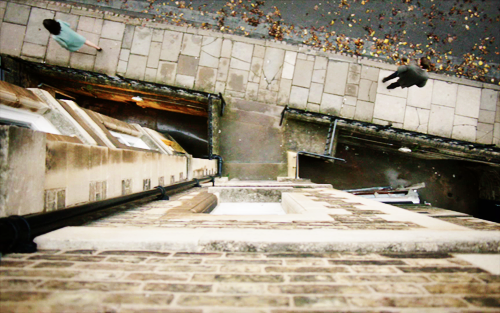
©itv/MammothScreen
ACT IV
‘ROCKET’
(The very rum truffle)
DAMIAN: Again, there was change in mood with the third film, ROCKET, which was perhaps a touch lighter in tone and humour. Is it a conscious decision to shape each film differently with its own unique identity and is this why every film has a different director?
RUSS: Well – each film has a different director for very practical reasons. Typically, the post production period of the first film occupies the shooting period of the second, and the shooting period of the second is the ‘prep’ time for the third film. I suppose it might be possible to bring back FILM 1 director for FILM 4, but it would be a lot to ask, as their schedule would run – prep FILM 1, shoot FILM 1, post FILM 1 – prep-FILM 4 – shoot FILM 4 – post FILM 4.
From my end – we only get to do four of these a year, and I want to try to get as much variety in as possible. It’s always Endeavour, but, hopefully, comes out of a different trap for each film. But it was lovely that we got Colm McCarthy back for HOME – a secret Dan McCulloch kept up his sleeve until the last moment.
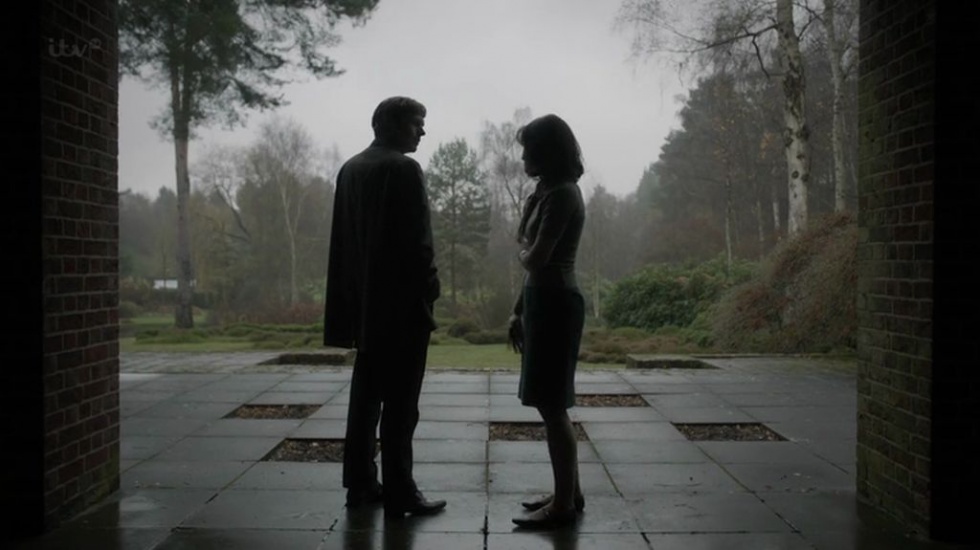
©itv/MammothScreen
DAMIAN: You’ve said in the past that there was a long and quite twisted backstory to writing ROCKET – would you care to elaborate for us please?
RUSS: You’ll have to jog my memory, as it’s quite a long time ago now. The final clue was always in my head – the accidental method whereby Endeavour unlocks the mystery. (Spoilers ahead!) Ah – now I remember. Yes. As I mentioned before, not everything you write ends up getting green lit and made, and some years ago – ten or more, I should think – I was asked to adapt a novel as 2×90 minutes. I… took some liberties. It was a pretty loose adaptation, as these things sometimes are, but I needed to find a way in, to make it more of a state of the union piece, and as a result I ended up looking at certain newsreels – amongst which sundry visits by members of the royal family were made to certain towns and factories, etc.. There was one with the DoE – it must have been the late 50s/early 60s – and the tone of it struck a chord somewhere. And then another of HMQ’s visit to… Stevenage, I think it was – there to admire the Thunderbird missile factory… Met by the Lord Lieutenant, etc.. ‘Have you come far?’ Bob Danvers Walker providing the narration. What a voice. And – to cut a long story – there was a changing of the guards at the broadcaster, and the new broom didn’t share their predecessor’s enthusiasm for the project, so it quietly died a death. But those newsreels were stacked away in the back of my mind…
Nothing is ever wholly wasted. A decade or so goes by… And thinking about stories for the first series of Endeavour, I remembered the newsreel. I’m fascinated by the long history of our island race – how EXACTLY did we get here? – changing social mores, &c. And the missiles and Her Majesty seemed too tempting to resist as a jumping off point. As soon as one thinks of factories and British films, a certain Boulting Brothers’ masterpiece (one of several!) can’t be far behind.
I thought it might be fun to have some kind of dynastic struggle behind the scenes amongst the owners of the factory. And the Plantagenets seemed a splendid model. Thinking of Henry, Eleanor and their fractious offspring brought to mind James Goldman’s staggeringly good The Lion in Winter. And the rest is…
So – those were the three things, the major ingredients for ROCKET stew.
I also had a the back of my mind that bit of folklore/urban myth about everywhere a royal personage visits smelling of fresh paint. So one takes that and puts it with the rest of it, and… Click!!!
Dan McCulloch brought us to director Craig Viveiros who was fairly untried with television. Little did we know that he wouldn’t just get the crate airborne, but would shortly dazzle us with barrel-rolls and loop-the-loops. Ridiculously talented just about covers it.
I’m very partial to a chamber piece – a precinct drama – which in effect is what ROCKET was. The factory and offices of Imperial Electric were a closed space. Our cut-off country house. We were two and a bit weeks in the old Tate & Lyle factory at Greenwich – possibly our longest stay at any location to date – which doubled for IEC — and I think the look Matt Gant (Production Designer) and his team of elves achieved simply dazzles. The way Craig and DoP John Pardue shot it… It’s just terribly stylish.
Likewise Chinon Court – the Brooms’ family home – which was Craig’s call for a location. I’d been terribly literal with the mediaeval vibe, but thankfully Craig, Matt and Dan saved me from myself, and went for this moderne masterpiece, which we then dressed with the odd bit of armour, etc., so’s not to lose sight of its inspiration. It fitted the look of the factory far more closely, and gave the whole thing a sense of completeness.
We were very lucky with our directors. Ed Bazalgette had the toughest gig of all, I think – opening the batting for us on GIRL; defending The Ashes almost, after the reception FBTW had received. He had so much on his shoulders – essentially setting up a new show – but he delivered with his customary brilliance, style and panache, and gave us not only a terrific film, but a perfect springboard for all that followed. An unbeaten double century.
But – back to ROCKET… Add the sublime Miss Jenny Seagrove, and the living legend that is Mister Martin Jarvis (every bit as lovely and mischievous as you might expect) as our Nora and Henry and it’s like all one’s birthdays and Christmases have come at once. That Martin had history with Morse (Greeks Bearing Gifts – What a film!) made the experience even more special. To hear that voice – THAT voice! – delivering one’s dialogue at the read… I mean… Come on!
DAMIAN: There are many moments for the fans to savour in this film but I particularly enjoyed the humorous exchanges between Morse and Strange (Bergman!) and the beautifully written and performed scenes with Alice Vexin (Maimie McCoy). I know Morse is currently busy with Nurse Monica but might we see Alice return one day?
RUSS: Yeh – dear old Strange. If not a cultural desert, then perhaps an area with very low precipitation. I’d forgotten about the Bergman, but now you mention it, that scene very nearly got cut from the final edit. Jokes are always a hostage to fortune – being seen as not furthering the plot, but I think I’ve said before, it’s the character stuff carries equal weight for me, and I think there might be some Jakes material lurking in this scene also, which probably saved it. You’ll have to forgive my memory – I haven’t seen it since it was broadcast. But, yes – Strange’s misunderstanding, possibly prefigures/draws on an exchange about Morse’s recent holiday destination in TWTTW…
Very sadly we did lose a scene between Dorothea and Strange, which came quite late in proceedings – once Endeavour was firmly on the scent. It is shot – and edited – and perhaps one day we’ll include all the stuff we couldn’t squeeze in. It’s a scene I like a lot – a rare two hander between Abigail and Sean. It sprang off the back of some oblique Endeavour mutterings in the cinema about Simeon Stylites. Also cut…
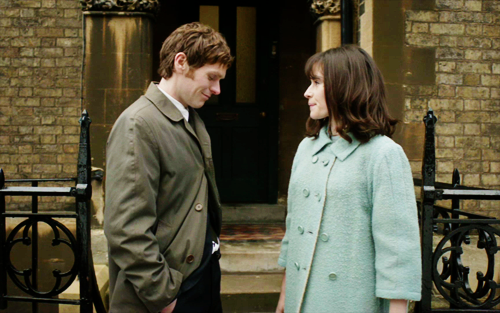
©itv/MammothScreen
Ah… Alice Vexin… in the person of Maimie McCoy. I thought it was interesting to turn the usual coat inside out and have a character who had carried a torch for Endeavour, or rather her idea of Endeavour – enhanced by the passage of time. As Jakes observes in TROVE – ‘absence makes.’ There’s little quite so attractive as that which one cannot have. But I think once, almost immediately, that Alice had got it out of her system that the bubble was burst, and she could see Endeavour was not the brightest of prospects for something long term.
In terms of Endeavour’s development, it felt right to establish in the fourth film we’d done that he wasn’t going to lead some kind of prissy, asexual, weirdly monastic existence. He might be unlucky in love by the time we get to meet him as a Chief Inspector, but to imagine, or, worse, to actively want his twenties and thirties to be just this arid stretch of nothing seemed to my mind unrealistic, immature and more than a little bit Annie Wilkes! You dirty birdy! Of course Endeavour taking someone to bed on screen (as t’were) was a break with tradition, but we hoped we’d bring the audience with us.
Maimie’s this luminous, ethereal screen presence. A very sharp, very sensitive actor – both strong and fragile at the same instant, which was just perfect for Alice. And she and Shaun just nailed that relationship. I particularly like the way Craig V and his D.o.P. framed those scenes at the table in the pub. Very Kubrick.

©itv/MammothScreen
One thing I’m keen to establish is the idea that Oxford is a living, breathing place outside of our adventures. The notion that Endeavour would not run into Alice, or, indeed, other characters previously encountered in a place so relatively small and socially insular (then! Before there are ‘letters’!) as Oxford strikes me as unlikely.
DAMIAN: As is now customary, please tell us a little bit about tonight’s film, SWAY – I believe you’ve been digging into Oxford history again?
RUSS: Yup, I’ve got a history of the Oxford City Police that contains a great section on Bonfire/Fireworks Night/November 5th, which was an annual blast of riotous town and gown mayhem. All leave was cancelled and the City Police deployed a large contingent of officers in ‘disguise’ to infiltrate the crowds and identify troublemakers for their colleagues to nab. I think I’ve mentioned before how the shooting schedule – late summer through winter – defines what we can and can’t realise, and so FILM by FILM the seasons progress – SWAY brought us to autumn, and November 5th seemed a good spot to hang the story on – there’s another reason it was chosen, which will become clear if you watch it, but I can’t go into it here for fear of spoilery.

©itv/MammothScreen
“Le Minou Noir”
~ Damian Michael Barcroft ~
Follow Damian on twitter for more exclusive interviews
~~~
The Inside Story
Each week we’ll be looking at what information we can glean from each of the Endeavour films concerning significant events and encounters and how they relate to the original series. Today we continue with our study of Fugue and Rocket…
Morse appears in The Oxford Mail with the following headline: ‘TOP OF THE COPS – DETECTIVE CONSTABLE IMPRESSES AUDIENCE AT OPERA RECITAL’. Fugue
The psychiatrist, Dr. Daniel Cronyn (aka Mason/Gull*), is asked to help profile the “Opera Phantom”. He makes reference to the growing trend in American serial killers and mentions Charles Raymond Starkweather, Albert De Salvo (The Boston Strangler) and also the bodies in the swamp at Fairvale (Fairvale is fifteen miles away from the Norman Bates/Psycho mansion and motel). Fugue
*It is interesting that Gull wishes to claim 5 victims – the same number as the canonical Jack the Ripper murders – one of the suspects was Sir William Gull. Fugue
Cronyn stabs Morse in the stomach with a knife. Fugue
Morse develops a fear of heights which he still suffers from in 1987. Fugue & Service of all the Dead
-Thursday’s family: Win (wife), Sam (son) and Joan (Daughter). Sam has/or is about to join the army and Joan works in a bank. Fugue
-Thursday speaks Italian. He came up through Italy after North Africa, landed at Reggio and then on to Cassino. Fugue
-Thursday also speaks German. Rocket
-There is a picture hanging on the wall of Thursday’s living room which is reminiscent of Housman’s “blue remembered hills”. The picture is to the right of Morse when he is resting shortly after the stabbing. Fugue
Oxford City Police are responsible for providing additional security while Her Royal Highness Princess Margaret is escorted on a tour of a factory for the official unveiling of the new Standfast Mark Two surface-to-air missile. The purpose of the visit is to help promote British industry abroad. Rocket
Alice Vexin discovers the body of Percy Malleson (aka Kendrick). Alice had a crush on Morse while at University and lived across the stair from Susan. Alice and Morse haven’t seen each other for seven years and he hardly recognizes her at first. Rocket
Morse tells Alice he has only been back in Oxford for a couple of months. Rocket
Morse and Alice meet on a date at the Fox and Hounds where she used to drink as a student. Morse says he likes police work but doesn’t fit in. Alice tells him that he was never like the rest despite Morse wanting and trying to be. She continues that he was difficult, awkward… all corners socially and so angry… but himself most of all.
After Morse’s failed relationship with Susan, Alice hoped he might seek comfort in her but instead, he just disappeared from her life.
Alice wears her hair like Susan did in the hope that it will remind Morse of her and perhaps be attracted to her. Morse says he doesn’t know if he is still in love with Susan but it is obvious that he is. Alice wonders if he could love her too.
Later, Morse and Alice spend the night together but soon afterwards, she tells him that she doesn’t think he is ready for a relationship and doesn’t want to be second best after Susan. The two go their separate ways. Rocket

